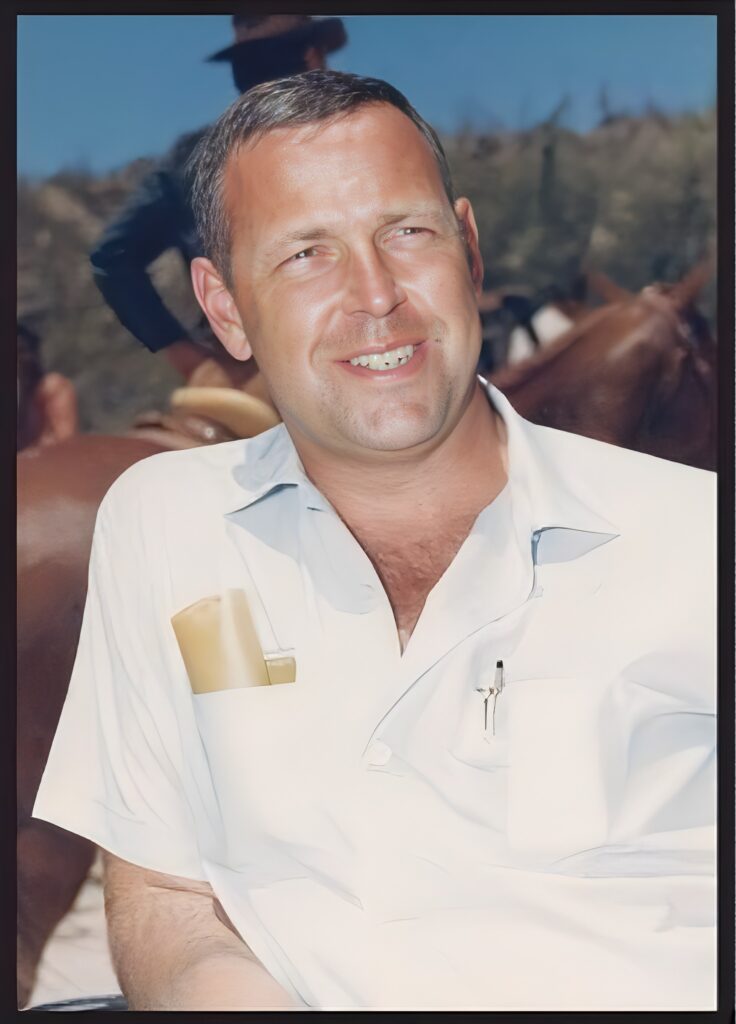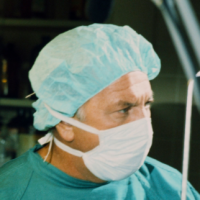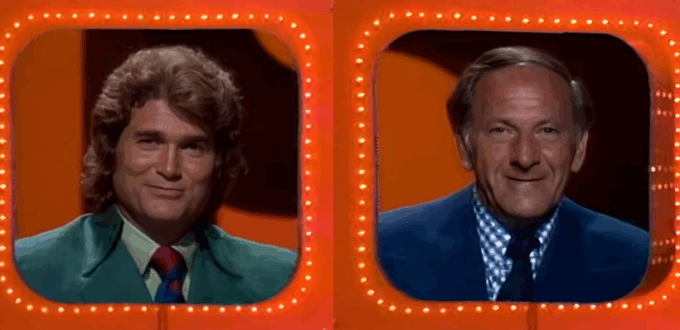The Surprising Primetime Parallels of NBC Giants Michael Landon and Jack Klugman
In the golden age of network television, Michael Landon and Jack Klugman emerged as two of its most defining figures. Though best remembered for vastly different roles—Landon as the earnest, soft-spoken Pa Ingalls on Little House on the Prairie, and Klugman as the blunt, justice-seeking coroner in Quincy, M.E.—both men transcended mere stardom. Each became a creative force who fundamentally reshaped the shows they starred in, turning formulaic dramas into platforms for deeply human, often moral storytelling.

They never formed a close personal friendship, and there’s no record of them socializing off-camera. Yet, they did appear together at least once in a rare public crossover—as celebrity panelists on Match Game ’73. The moment was brief and playful, but in hindsight, symbolically rich: two future dramatic heavyweights sharing a single stage before stepping into the more serious legacies they would later build.
Although separated by nearly 14 years in age—Landon was born in October 1936, while Klugman was born in April 1922—their professional lives followed curiously similar trajectories. Both were fiercely committed to their visions, clashed with their shows’ original creators, and ultimately redefined the tone and message of their series. Despite existing in different Hollywood circles, they shared something far more enduring than friendship: a creative temperament that favored principle over passivity.
They Knew Johnny Too
Both actors were regular guests on The Tonight Show Starring Johnny Carson, and each used the platform to reveal dimensions of their personality that audiences didn’t always see on their dramatic shows.
Landon, in particular, was a Tonight Show favorite, appearing at least ten times—once even as a guest co-host. He charmed viewers with his humor, vulnerability, and polished storytelling, sharing the couch with legends like Bob Hope, George Carlin, and Bo Derek. Landon’s appearances often coincided with major career milestones, promoting Little House on the Prairie or his later series, Highway to Heaven. His interviews reflected the same emotional honesty and warmth that marked his work on screen.
Klugman’s most memorable moment came on July 6, 1982, when he appeared during a special Tonight Show episode guest-hosted by fellow South Philadelphian David Brenner. Their shared hometown roots made for a naturally spirited exchange. Alongside actor Paul Sorvino, Klugman and Brenner swapped stories full of neighborhood grit and affectionate sarcasm. The clip has since resurfaced on YouTube, preserving Klugman’s off-screen charisma and quick wit for a new generation.
Parallel Paths, Parallel Battles
The Actor as Auteur: Rewriting the Script
At a time when most actors simply delivered lines, Landon and Klugman took an entirely different approach. They became de facto auteurs—writing, producing, and even directing, not because they had to, but because they believed television could do more than just entertain.

Michael Landon: Turning Sentiment into Substance
Landon was brought onto Little House on the Prairie by executive producer Ed Friendly, who intended a gentle, faithful adaptation of the Laura Ingalls Wilder books. But Landon envisioned something deeper. Rather than adhering to a nostalgic recreation of pioneer life, he introduced emotionally charged narratives—tackling subjects like alcoholism, racism, and terminal illness. By the second season, he had assumed full creative control, and the series evolved into a moral and emotional cornerstone of NBC’s lineup.
His vision wasn’t about recreating the past; it was about resonating with the present. He directed over 80 episodes, wrote many more, and infused nearly every frame with his signature mix of sentimentality and purpose. Under Landon, Little House became less about prairie life and more about the universal struggles of family, loss, faith, and perseverance.
Jack Klugman: From Sleuth to Social Conscience
Klugman’s transformation of Quincy, M.E. followed a similar path but with a sharper edge. Initially part of NBC’s “Mystery Movie” rotation alongside Columbo and McCloud, Quincy began as a standard procedural centered on forensic science. But Klugman had grander ambitions. A trained stage actor with a passion for social justice, he reimagined Quincy not as a slick medical sleuth but as a fierce advocate for the voiceless.
He worked closely with real-life coroners, including Dr. Thomas Noguchi, to ground the show in authentic forensic detail. More importantly, he shifted the focus from whodunits to why-did-this-happen narratives—episodes that addressed issues ranging from airline safety to public health failures and mental illness. Klugman believed television had a duty to reflect and respond to the real world—and he fought for that conviction, often clashing with co-creator Glen A. Larson and NBC executives.
Creative Independence: Shared Battles, Shared Impact
Landon and Klugman didn’t just resist creative interference—they rewrote the playbook. Both men inherited shows with clear production visions, only to bend them into vehicles for personal and thematic expression.
Landon’s divergence from Ed Friendly’s literary vision caused early tensions, but it gave the series a broader emotional reach that connected with millions. Klugman’s insistence on shifting Quincy toward issue-based episodes turned the show into a socially charged drama unique in its genre. Both actors were willing to risk professional relationships to stay true to their values, which is why their shows still resonate decades later.
Their assertiveness wasn’t about ego—it was about integrity. They were not content to be pawns on a network chessboard. They were architects building platforms for human connection, social dialogue, and moral clarity.
Loyalty, Legacy, and the Long Goodbye
For both Landon and Klugman, loyalty extended far beyond storylines. It was deeply rooted in how they treated their casts and crews.
Landon was famous for carrying collaborators from one project to another. From Bonanza to Little House to Highway to Heaven, he maintained a trusted inner circle, creating a stable and supportive work environment. This continuity wasn’t just convenient—it was purposeful. Landon believed consistency behind the scenes fostered better storytelling on screen.
Klugman, for his part, cultivated respect through his no-nonsense but fair approach. While he challenged writers and executives to raise their game, he championed equity and dignity for the people who made the show possible. He wasn’t afraid to be difficult if it meant producing better, more meaningful television.
When the time came to end their shows, both men did so on their own terms. Landon ended Little House with a literal bang—blowing up Walnut Grove in the series finale as a symbolic refusal to let NBC repurpose the town or its story. Klugman’s departure was less theatrical but just as resolute. After growing conflicts over creative direction and a lawsuit regarding syndication profits, he walked away knowing he had elevated Quincy into something far more important than the sum of its parts.
Emmy Time: Rival Competition or Programmatic Cooperation
Little House on the Prairie and Quincy, M.E. might seem like opposite ends of the TV spectrum—one a wholesome frontier family drama, the other a gritty modern-day crime procedural. But beneath their distinct tones, these NBC juggernauts shared unexpected common ground—on screen and at the Emmys.
Airing on Monday nights at 8 PM from Season 3 onward (1976–1983), Little House brought family-friendly drama rooted in 19th-century morality. Quincy, M.E., which began as part of the NBC Sunday Mystery Movie in 1976, became a regular series and aired Sundays at 9 PM for most of its run starting with Season 2 in 1977. Though they aired on different nights, both shows contributed to NBC’s broader ratings battle against ABC’s slick variety shows and CBS’s drama-heavy Sunday and Monday lineups.
They didn’t compete directly for viewers, but each faced off against aggressive programming from rival networks. Little House squared off with ABC’s That’s Incredible! and CBS sitcoms. Quincy contended with blockbuster TV movies and shows like Dallas. While their core audiences differed—families and moral idealists for Little House, adult viewers drawn to realism and reform for Quincy—both appealed to those craving substance and justice in storytelling.
Award-season overlap added another wrinkle. Little House often earned nominations for music, costume, and production, while Quincy received nods for writing, directing, and Klugman’s performances. Despite different Emmy categories, both series pursued impact-driven narratives and social resonance—whether through the emotional struggles of Laura Ingalls or Quincy’s crusades against systemic failure.
So while one show looked backward and the other confronted the present, both Little House and Quincy shared a surprising kinship: iconic stars, message-driven drama, Emmy aspirations, and a legacy carved not only in prime-time.
Epilogue – Not Friends, But Kindred Figures
While Michael Landon and Jack Klugman may not have formed a lasting friendship, they undeniably shared a unique moment in television history: working on the same network, NBC, during overlapping sweeps periods, and embodying a similar artistic drive. Though their shows—Little House on the Prairie, filmed primarily on Stage 31 at the Paramount lot, and Quincy, largely shot on the studio’s backlot—were worlds apart in style and setting, it’s easy to imagine that their paths might have crossed behind the scenes.
Perhaps somewhere near the commissary, tucked behind the stages and lots where their vastly different productions came to life, they caught sight of one another. Between the demands of rehearsals and script rewrites, between battles with ratings and network pressures, maybe there was a moment—a silent acknowledgment that both men were fighting for something bigger than just entertainment.
Picture a fleeting encounter on the lot: one stepping away from a tense rehearsal, the other heading to polish a critical scene. A nod exchanged in passing, a glance that said, “You too?” Maybe a quick word about the weather, a recent ratings bump, or a memorable appearance on The Tonight Show with Johnny Carson—no cameras rolling, no audience watching—just two seasoned professionals sharing an unspoken understanding of the weight they carried.
They knew the stakes intimately. They understood the relentless grind. They lived the dual role of being both the public face and the creative conscience of their shows. And they knew what it meant to sit beside Johnny Carson—not merely to promote a project, but to be momentarily seen as more than just a character, as artists with stories that mattered.
Perhaps Landon and Klugman never shared a meal, exchanged phone calls, or holiday greetings. But they shared something rarer: a mutual recognition born of the unique pressures and triumphs of their craft—a quiet fraternity only a few in the industry ever truly earn.
They were both, in their own way, legends. And they both knew Johnny, too.
And maybe that was enough.
Sources:
- Taped interviews with Glen A. Larson, Jack Klugman, and Kent McCray via the Television Academy Foundation.
- YouTube: Tonight Show Starring Johnny Carson – David Brenner hosts, July 6, 1982.
- IMDb & Wikipedia: verified episode appearances and production details.
- TV Guide archives on NBC’s Mystery Movie wheel and Little House scheduling.
- LA Times archival profiles on Dr. Thomas Noguchi and Quincy’s real-life inspirations.
- Arngrim, Alison. Confessions of a Prairie Bitch. New York: St. Martin’s Press, 1998. (Reference to Little House on the Prairie).
- Butler, Dean. Prairie Man: The Evolution of a Little House Hero. Nashville: HarperCollins, 2010. (Reference to Little House on the Prairie).
- Grassle, Karen. Bright Lights, Prairie Dust: Reflections on Little House and Life. Boston: Beacon Press, 2009. (Reference to Little House on the Prairie).

Chief online influencer of all things Quincy. Currently, I operate as a content creator & editor to The Quincy Examiner – Online Home to the godfather of all today’s forensic detective TV series. When time permits, I run the gauntlet with young and old family members as we surpass this post-COVID pandemic! I follow up with all communication but the social links below are probably the best way to find me quickly! Enjoy the site and come back again soon… that’s doctor’s orders! Be well!

No Comments Yet